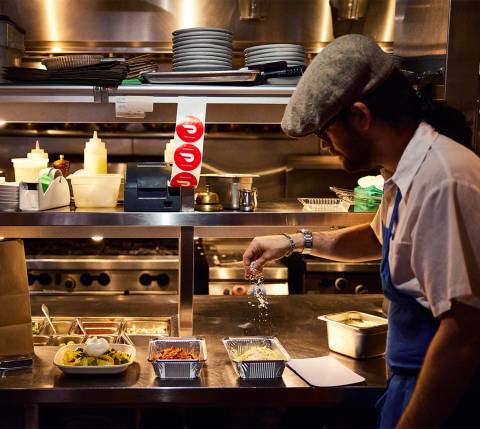There are several questions to consider when it comes to your restaurant location strategy. First and foremost, what is your operating budget as you begin your new endeavor? Running a restaurant business is expensive, and your current capital and projected earnings will determine how much you can spend on rent. The cost of that rent will be decided by the amount of space you’ll need, and the area you want to operate in.
Beyond that, there are additional questions that are equally relevant, even if they’re not as readily apparent. That’s why a comprehensive location analysis can be beneficial for business owners. Location analysis encompasses all sorts of market factors — from customer demographic profiling to understanding local and regional regulations — that enable you to make the best possible decision when choosing a location for your restaurant.
Understand your restaurant's purpose and target demographic
Fast-casual restaurants, cafes, and food trucks all have vastly different needs when it comes to restaurant location strategy. To figure out yours, have a clear concept of what type of business your restaurant will be, and what experience you want your customers to have. Here are important questions to ask yourself before opening up a restaurant.
What is your restaurant vision?
Whether you’re looking to open a friendly neighborhood spot or an upscale fine dining establishment, the right space will make your restaurant dream a reality. And in that search, you should not only consider the atmosphere and ambience you want to create for your customers — for example, the height of the ceiling, access to natural lighting, and availability of outdoor seating — but you also need to think about who those customers will be.
Who is your menu designed for? A location analysis factors in customer demographics and psychographics for good reason. Different restaurants appeal to different types of people. Make sure that local residents are consistent with the age range, family or relationship status, and income bracket that your restaurant appeals to. Cultural backgrounds or beliefs can also affect dietary restrictions.
Government resources like the US Small Business Administration’s database are excellent for market research to inform your restaurant location strategy and location analysis.
How will your kitchen plan meet your needs?
Your ideal kitchen size, space, and layout will depend on the cuisine you plan to serve. Are you baking wedding cakes or slicing sashimi? To devise the right restaurant floor plan, start by thinking about what exactly you’ll need from your kitchen and food prep spaces to create your menu.
Your restaurant location strategy can take into account different kitchen layouts to facilitate the flow of food to plates and plates to customers. Whether you want to organize your workspace in zones, as an assembly line, or in a central island, depends on what you’re making and who you’re serving.

Is your restaurant optimized for delivery?
Will customers primarily dine in or order food to go? If your goal is to create a memorable in-house dining experience, you’ll need the space to do so. In fact, some experts recommend restaurants allocate 60% of their space to diners and the other 40% to operations. However, if you don’t plan to serve many customers in your space, you can be more flexible.
Preferences for dine-in versus delivery may vary depending on whether your restaurant is in an urban, suburban, or rural location. But according to the National Restaurant Association, “hybrid” restaurants that connect with patrons both on- and off-premises are not only trending, they’re also becoming the new norm.
Creating a designated area for delivery pickups could be factored into your floor plan if you intend to make delivery a part of your business model.

"We installed shelves for both Dasher and customer pickup, and rearranged our shops to help with the flow. But oddly enough, it made us realize we have a lot more space than we thought. It gave us a chance to rethink our layout and make the day-to-day flow a lot easier."
Research neighborhoods for your restaurant
The next phase of your location analysis is neighborhood research. Neighborhoods have distinct personalities, and you want to make sure your restaurant fits the character of its surroundings. Spend time in the areas you’re considering and take note of what you see. Try to vet potential locations from a customer’s point of view.
Here are a few questions to consider when reviewing neighborhoods for a restaurant location strategy:
Is it busy or quiet during the day? Does this change in the evening or during late-night hours?
What is this area’s reputation when it comes to safety?
Are there a lot of office buildings or other places of work nearby, suggesting a thriving lunch crowd?
Do other local businesses rely on foot traffic, or do people generally drive to and from the area?
What other restaurants are nearby? If they’re similar to yours, it can be difficult to compete with a local incumbent — but if they’re different, then you can contribute to the diversity of the area.
Is seasonality a factor for that neighborhood? Do people tend to visit the area more during certain times of year depending on tourism, weather, or local community activities?
The answers to these questions will help provide key data points about the neighborhood's competitive landscape, foot traffic, and the local market. In your restaurant location strategy and analysis, you can also pay attention to the turnover rates of local businesses. If past merchants have failed, what were the contributing factors — were they restaurants as well?
Note these variables as you build out your restaurant business plan.
The importance of logistics
Details like parking options and street visibility are critical factors in conducting your location analysis. Providing an easy place to park can be what brings diners to your door, and great street visibility can attract new customers who wouldn’t have discovered you otherwise.
Take the time to contemplate details like these when searching for the best location for your restaurant:
Is this space accessible? If you plan to host diners onsite, you want to make sure that your space is inviting and easily accessible. Is it walkable from public transportation hubs, or does it have sufficient parking? As you imagine a potential layout, consider whether the space will comply with accessibility regulations.
Will the location provide good visibility? Think about how many times you’ve stumbled upon a restaurant and fallen in love — now think about where those restaurants were located. An inviting storefront on a busy street can be all you need to reel in hungry customers and turn them into regulars. A location where customers need to already know about your restaurant might hurt your business — or be a boon, if your brand thrives on being under the radar (and you plan to have a strong social media strategy).
Is this space compliant? While not the most exciting part of a restaurant location analysis, understanding relevant local and regional laws — and obtaining the right permits — is essential. Zoning for commercial use, protocols for health and safety, and even labor laws related to hours, wages, and tips can vary across cities and states. Bringing in a building inspector to verify the integrity of the structure and infrastructure is also a must as you shortlist your top location choices.

How to choose a restaurant space
Unless you’re looking at newly built properties, it’s also important to think about the past life of a building or storefront. What type of establishment used to occupy the space you’re looking at? For example:
Is there an existing kitchen? If you’re moving into a space that was previously a restaurant, you may assume that it will have the appliance infrastructure necessary to support yours — but that isn’t always the case. The ovens needed for a bakery differ tremendously from the fryers needed for a burger joint. You don’t need to move into a space that has 100% of what you need, but you do need to move into a space that’s capable of supporting the type of equipment you plan to use.
What will you be replacing? If you’re opening a late-night spot in what was formerly a quiet cafe, your introduction to the neighborhood might cause a stir — which could be a good thing, but it’s something to be mindful of. If you plan to serve alcohol, investigate whether the former occupants also had a liquor license.
Another factor to keep in mind is your restaurant’s supply chain. What staples will you need to run your business and serve your customers, and where can you source them from? If you plan to receive large inventory shipments, choose a space that can accommodate them.
Location analysis can be complex, but if you find a neighborhood where you know you can contribute something special, then have confidence in your vision and introduce yourself to the local community.

"If you want to open a new location, you think you have a good idea, and the math seems right, you should do it. Otherwise, when you get old, you might regret it."
More assistance with your restaurant location strategy
Because a restaurant's location is so important, finding the right space can be the most time-intensive part of opening a restaurant. Whatever location you choose for your restaurant, a partner like DoorDash can help you connect to customers in your area, market your restaurant, and drive delivery sales. Learn how to optimize your location for pickup and delivery, and sign up for DoorDash today.





